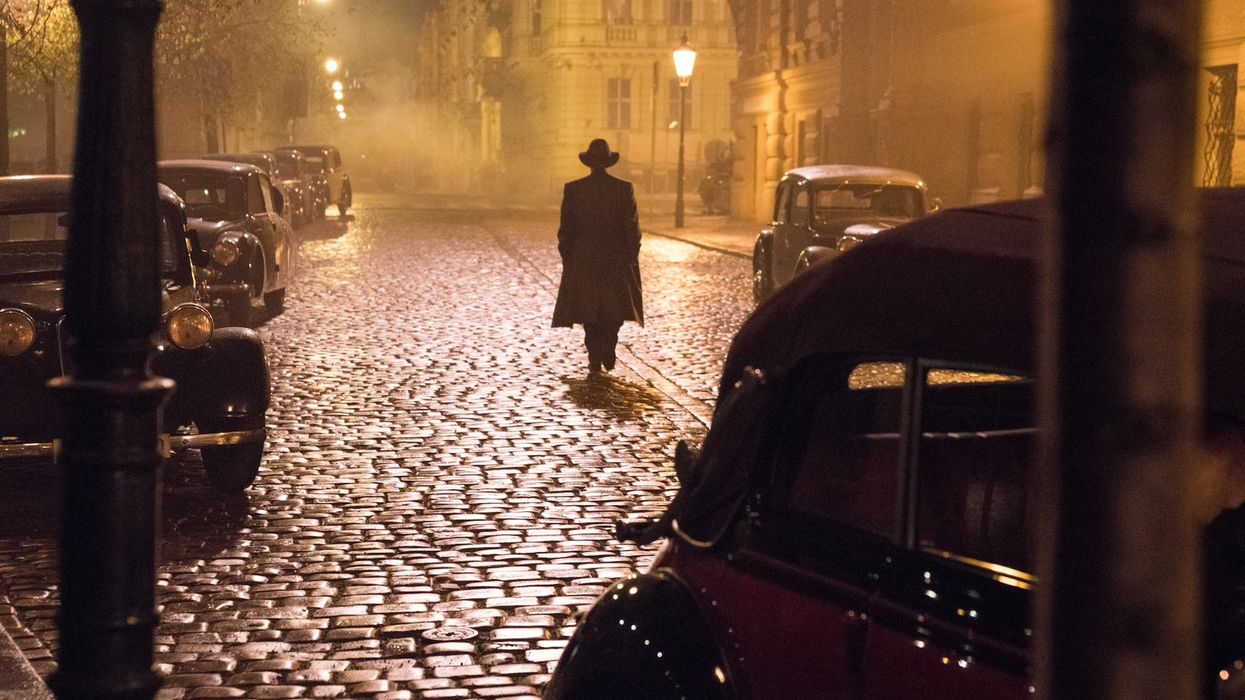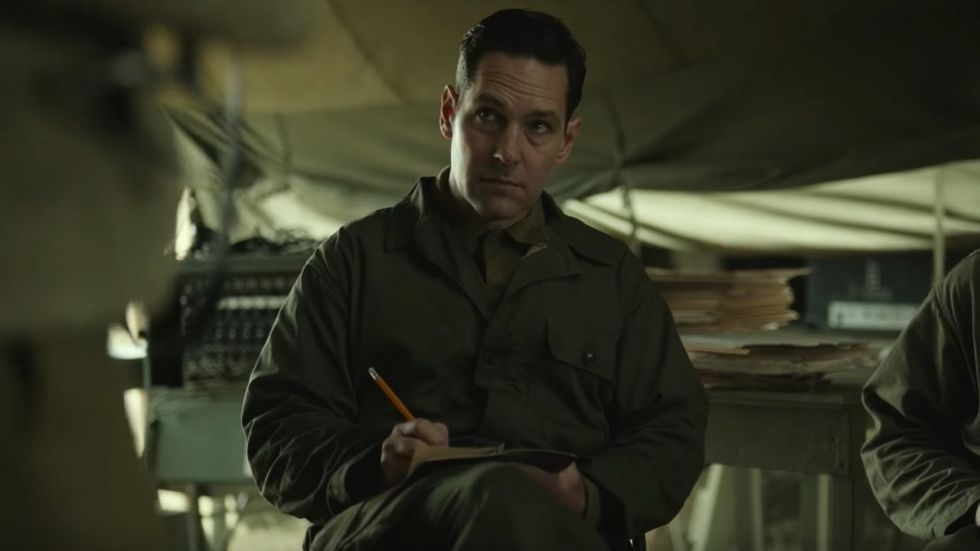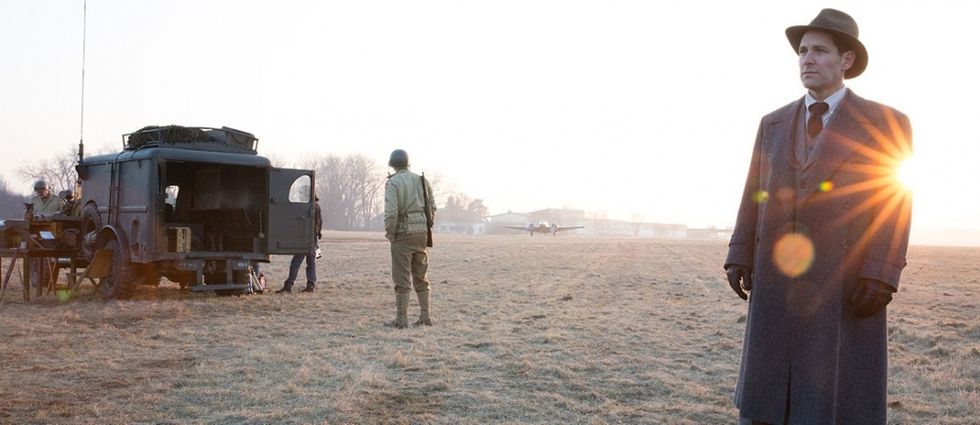How DP Andrij Parekh Used Noir Lighting to Modernize 'The Catcher Was a Spy'
For DP Andrij Parekh, cinematography involves working within a location's constraints to achieve a desired effect.

Who is Moe Berg? In Ben Lewin’s new film, The Catcher Was a Spy, this question drives everything forward, including Paul Rudd’s complex performance as Berg, a multi-lingual Princeton-graduate-turned-baseball-player-turned-spy on the trail of Nazi sympathizer/scientist Werner Heisenberg.
The question also guides the film's lush and often intensely moody cinematography of Andrij Parekh, whose other films include Half Nelson, Blue Valentine, It's Kind of a Funny Story, and Madame Bovary. The film is steeped in classic cloak-and-dagger imagery—the foggy alleyway, the dimly lit office, the shadowy cafe—and thus tells a story visually independent of the World War II drama at the forefront. While we can thrill at Berg's chase of his target and wince at his near-escapes and violent interludes, we're also thrilled as the movie turns him over and over again, showing us different sides without allowing us to linger on them long enough to draw any conclusions.
As the film is now in theaters, No Film School spoke with Andrij Parekh about how he explored Berg's life, character, and historical milieu.
No Film School: Much of the film is in darkness or half-lit. How did you explore that darkness cinematically? What led you to that choice?
Andrij Parekh: The story, for me, centers on the enigmatic Moe Berg, a character who was rather hard to read and understand. We deliberately put him in shadows to accentuate his enigmatic qualities; in one scene, he’s being interviewed to join the O.S.S. (predecessor of the C.I.A.), by William Donovan (played by Jeff Daniels), who asks very pointed questions about Berg’s personal life and sexuality. It’s a terrifying moment for Berg, and he’s put on the spot—so I completely front-lit Paul Rudd, exposing him fully when he’s asked all those questions about his personal life. In that scene, I wanted to show that, in that moment, Moe Berg was almost being unmasked, in a way, just through the use of light and shadow. The film The Conformist was a huge influence on Ben and me. That film was very much about a man who was hiding his past, and that was the approach.
"The tricky thing about doing period pieces is modernizing them."
NFS: Did reading the book by Nicholas Dawidoff on which the movie is based affect the way you shot the film at all?
Parekh: The tricky thing about the book was that I read the book before shooting, and I knew as much about Moe Berg on page 1 as on page 250. The book was not very helpful to me in terms of understanding Moe Berg. It contained a lot of facts, but the facts didn’t really connect any emotional dots in my understanding of Berg.
NFS: Did your visual ideas about the film develop in tandem with the director, or were you allowed fairly free rein creatively?
Parekh: Ben had some very strong ideas about certain shots he wanted, but he basically gave me very free reign in terms of the lighting approach and camera movement. The tricky thing about doing period pieces is modernizing them. I wanted to give it a more modern feel that still held true to the period.

NFS: How would you say that modern feel played itself out in the film?
Parekh: I think, in many ways, it’s very classically shot. What maybe feels more modern about it is the lighting—we wanted a kind of noirish approach, with the light and shadows, but it was also about not having hard light and black shadows, but rather having soft light and then milky black or open shadows. That helped modernize the way it felt. Chiaroscuro, but with a more open, modern feeling to the film. It was sort of about seeing into the shadows and allowing your mind to create a narrative.
"Working digitally, you can see what everyone’s doing at the same time."
NFS: How did you develop and plan the war scenes, in light of what you’re saying about wanting to modernize them?
Parekh: The thing about those battle sequences was that we were on a pretty tight budget—we had 30 shooting days, and we basically had two days to shoot that entire battle sequence. We shot it with 4 cameras. The nice thing about working digitally is that you can see what everyone’s doing at the same time. I wasn’t operating any cameras for that—I was basically just orchestrating how the different cameras were seeing everything. We spent a day rehearsing with the actors and working out the blocking, so there was no question of what we were shooting. There were a lot of special effects—everyone’s hair was full of dust and debris at the end of the day.
There are always those challenges, just to get the shot—you need a certain number of shots just to get those scenes to move editorially, so for me, it was about trying to get as much coverage as we could. I worked out the blocking, and then I just tried to get in there and get those moments, like the point where Giamatti watches the Corporal get shot. There were very few times we used slow motion in the film, and that was one of the moments. It’s the first time, we assume, that Moe or Giamatti’s character has seen battle, so it’s very important for us to be close to them and see their experience and shoot it maybe a little more subjectively than objectively.

NFS: What was your advance work for the movie, in terms of developing a visual arc for it?
Parekh: I like to work very closely with production design and costume, in terms of color and tone. We did a lot of testing—we tested a lot of costumes for Moe Berg. I had the sense I gave the costume department a bit of a headache- rejecting costumes because they wouldn’t work with my lighting approach. Initially, they wanted to give the characters black suits, and you’d have to put a lot of light on the suit itself just to get any detail out of it. But on a tight schedule we couldn’t spend that kind of time. So, there was a lot of collaboration between the costume department, production design, and myself in terms of finding a visual style. I gave them a kind-of lookbook to show them what my approach was going to be before we started, and that was based on a lot of paintings and a couple of film stills, but it’s always tough to make a visual arc for a film, because the location really dictates how you’re going to shoot it, and I find the actors also dictate how you’re going to shoot it, in terms of what they’re doing and the emotional tenor of a scene, and so I don’t always like to go into a film with those visual ideas locked.
For me, it’s just about controlling color and palette as much as possible and then having the wherewithal to take what the actors are giving you and use it to inform the camera work, rather than the other way around. I think the performances are quite strong in this film, and I think that’s partially due to the way we shot it, allowing them to dictate where we were placing the camera. If you go in with a set plan and the actors are doing something that doesn’t work for the plan, you can’t force them to follow a plan that’s not working. It doesn’t serve anyone. I try to bring out great performances, and hopefully we did that.
"I find that actors are very much like plants—they know where the light is, and they go there."
NFS: You mentioned you supplied paintings and film stills. Which paintings and which film stills?
Parekh: There’s a Czech painter I love, named Jakub Schikaneder, a 20th-century Czech painter. I studied him in Prague, where we shot the film. I had a professor at the FAMU film school who introduced me to his work at an exhibition. His paintings are so striking in terms of their use of light and shadow. There’s also no true black in his paintings, and that was what I was going for in this film, a lot of open black and shadow play. We used stills from The Conformist, which dictated a lot of the way the movie looked.
NFS: What other research did you do for the film?
Parekh: We watched a lot of Hitchcock films. There's also one called The Lives of Others that I brought to Ben, and Tinker, Tailor, Soldier, Spy, too. For me, prep was about spending time with Ben and going through the script and understanding the beats and trying to understand who this man (Moe Berg) was, and that was what the film was, for me, a search for understanding.
I had five weeks of prep. I spent a lot of time on location, watching the light, seeing what the light does and then blocking for that, giving suggestions to the actors about where to go and how to block scenes. I find that actors are very much like plants—they know where the light is, and they go there. So, my work is always very much based on the structure of the location and where the natural light is coming from.
'The Catcher was a Spy' is in theaters now. For more information, click here.











